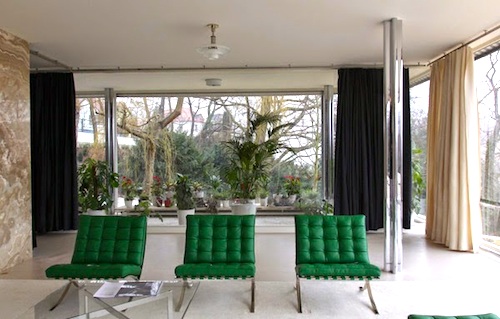By Joe Bendel. Mies van der Rohe’s Seagram Building might be an exemplar of International style architecture, but its glass and steel basically are what they are. That is often the case with his American work, but the Villa Tugendhat in Brno is something else entirely. While it still reflects his modernist aesthetic, it also happens to a house that breathes and welcomes occupants. It is a surprisingly livable space, which is why it has been consistently repurposed by subsequent appropriating regimes. Dieter Reifarth chronicles the history of the home and its original [rightful] owners in The Tugendhat House, which screens during this year’s New York Jewish Film Festival.
Reifarth opens the documentary by opening up Tugendhat House, slowly panning through its restored rooms and open flowing spaces, as disembodied voices read the polarized reviews it originally garnered in the architectural press. The Tugendhats no longer reside here, thanks to the National Socialists and the Communists who followed them, but philosopher Ernst Tugendhat fondly remembers the years he lived there as a small boy. So does one Tugendhat sister, but the youngest was born while the family was in exile. However, the entire Tugendhat-Guggenhein-Hammer family takes an active interest in the restoration campaign, including one who happens to be a refurbishment expert.
Although they lost many extended family members to the Holocaust, the Tugendhat nucleus managed to get out while the getting was good, resettling in Switzerland and later Venezuela. Given their sensibilities, it is rather remarkable the Tugendhat House survived the Nazi and Soviet occupations. While the Germans simply used it as another piece of prime real estate to dole out as they deemed fit, the Communist authorities fashioned it into a long-term children’s spinal clinic. Frankly, the Tugendhat form seems completely ill-suited to such a function, but former patients found the natural light quite cheerful. Decades later, the final divorce decree between the Czech and Slovak Republics was ironed out there, permanently fixing the building in the Czech collective memory.
T House is an unusually balanced fusion of architectural appreciation and sweeping history. If you don’t know Ludwig Mies van der Rohe from Ludwig von Mises you might find many passages of the film rather archi-geeky. Nevertheless, Reifarth really gives you a vivid sense of the villa as a distinctive space and place. He also doggedly follows the twists of the Tugendhat family story, as well as the wider cultural context of their increasingly iconic home.

After watching T House, the Villa Tugendhat will almost assuredly become viewers’ favorite Mies van der Rohe building, which may or may not be thunderous bragging rights given their respective interest in the art and practice of architecture, but that still means it is rather smart and effective as a work of documentary filmmaking. Of course, for those who are well versed in Mies van der Rohe and the International School, it is like catnip. Yet everyone should find some meaning in the tragedies and resiliency of the Tugendhats’ exile experience. Highly recommended for those fascinated by the art and history under discussion, The Tugendhat House screens this coming Wednesday (1/28) at the Walter Reade Theater, as part of the 2015 NYJFF.
LFM GRADE: B
Posted on January 24th, 2015 at 5:57pm.